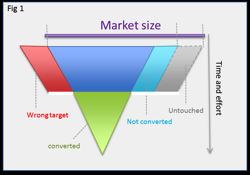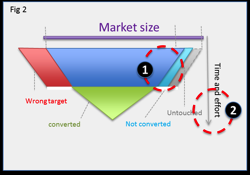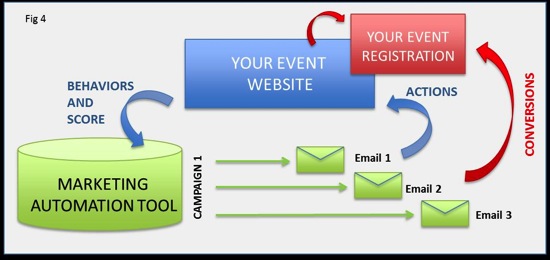Skift Take
Fig 1
This is a sponsored post written by Nicola Rossetti, Chief Strategy Officer at etouches.
More information about Event Manager Blog’s sponsored posts.
Imagine you are a golf course owner; you can decide to send an army of grounds keepers to water the fairways and greens, or build an automatic watering system that reacts to conditions (temperature, rain, etc.) to run when and where it’s needed. What would you do?


An event is a medium; in most cases it requires marketing efforts. Your little sister’s surprise birthday may not fit with the definition, but most events, especially large ones, involve months of preparation. Professional events are here to provide attendees with networking and key learning (best practices, products) opportunities. That requires some recruitment efforts: recruitment of valuable speakers, exhibitors and attendees.
If you are running events using excel, don’t read this post – actually, read it twice! Today’s world cannot bypass (unless it’s your little sister’s surprise party) the use of software to manage professional events: logistics, booth design, budgeting, networking and MARKETING!
Marketing for Events
Marketing involves a number of components: the communication aspects (brand values, look and feel, message, and value propositions) and the channels you will invest in to capture your audience (website, SEO, social media, emails, blog, and webinars).
Your marketing efforts are not only designed to capture attendees, but in some cases are to recruit speakers (speaker management and call for abstracts) or exhibitors.
That’s a lot of time and money needed for marketers who feel the pressure to get results, as the success of the event is often tied to the relevancy and the volume of attendees.
Automation is more like “Automanual”
Make no mistake, marketing automation is not a magic wand that bestows you with new skills and bandwidth, but rather a different marketing approach that consists of building a process upfront that optimizes time and efficiency afterward. You are certainly not going to be replaced by a robot; you are actually going to be the teacher to the robot, its caretaker if you will.




shows classic marketing approach, while Fig 2 shows eMarketing automation. In Fig 2, notice the reach is bigger against the market size by maximizing the conversions and by reducing the time to convert your potentials into participants.
What are the Components of eMarketing Automation?
Marketing automation initially comes from the ecommerce world. Known for being a precursor in marketing techniques, ecommerce always focuses on optimizing the conversion processes. Although anyone could claim ecommerce and events are two different animals, there are some techniques that are certainly applicable if three steps are clarified first:
a) The acquisition of the attention: you have made someone aware of your event
b) The acquisition of the profile: someone has decided to register
c) The optimization of the acquisition: you capture behaviors and you sell/offer more relevant content or products
Clearly, ecommerce has utilized behavioral marketing for some time now. For example, many years ago Amazon was offering book suggestions to potential consumers based on the books other people bought who matched their same behavioral profile. Interestingly, behavioral marketing also has a role to play in steps A and B.
In today’s world, data is king. If you’re running a hosted buyer event, wouldn’t you be happy if you knew a potential visitor went to relevant pages on your website and looked at exhibitors? Don’t you think you have higher chance to convert a visitor if you expose him/her to sessions that are the most relevant to their environment? Do you think that 100% of your emails are being read, clicked and end up with conversion?
This is where eMarketing automation takes place: Not only are there now great tools, solutions and software on the market to help you gather that intelligence, but the ecosystem is in place – blog, website, emails, CRMs, and event software.
Talking About the Ecosystem
eMarketing automation is not just a standalone solution, it works dynamically with other solutions. An example can be your website: while you may program automatic email campaigns, they will feature links to landing pages on your website. Given the behavior of the user (clicking or not, clicking here instead of there, navigating to those pages) you will be able to score this and offer your potential attendee with a more targeted communication, leading to conversion.
That shows the first interaction between your website and the automation piece. Often, the automation tool offers tracking codes (just like Google analytics) to implement within your webpages to captures behaviors/scores.
When do I Apply eMarketing Automations for my Event?
Compared to ecommerce, events face a different life cycle. You don’t often recruit year round for events. Thus, eMarketing automation could be quite time consuming upfront, but it makes sense to consider it when your marketing effort/budget is substantial, meaning you run a large event or several events.


Fig3. shows the levels of sophistications (skills/ bandwidth) you need to consider to run efficient automation programs. Remember, the structure is radically different here as the workload is upfront. Again, this is all about critical mass.
Setting up a Marketing Automation Program
Once you have selected the right tool that fits with your ecosystem (think integration, use of APIs, etc. your data needs to flow seamlessly within your ecosystem), you must consider several steps in the process:
1) Set up your goals
2) Assign responsibilities for the project
a) A project manager that will identify the actors, evaluate the phases and coordinate
b) Set up a budget
c) Train people for the roll out phase (post project)
3) Determine your environment:
a) Event software
b) CRM
c) eMarketing automation
d) CMS or website
You need to consider eMarketing automation as the ability to plug in scheduled communication given certain criteria. You need to identify the number of “programs” (email campaigns, their content, and the behavior you want to capture) to send more performing messages, which will increase your conversion.


Fig 4. shows 1 campaign made of 3 emails and each action from the email (click, no click, time, follow up etc.)
We chose to implement Silverpop as our marketing automation tool. We defined our targets, as well as a pool of leads to “nurture” (they can be potential attendees or exhibitors to contract with), until they are qualified enough to enter the sales process.
In terms of feedback, it’s a six month process with two resources per time (say 20% of the time) and 30 hours of external consulting as we started from scratch. Although we implemented link integration between systems (Silverpop talked to Salesforce), we had to implement the web tracking process, the scoring rules and the campaigns themselves. Here are some non-exhaustive examples of score against behaviors:


Fig 5. shows some examples of scoring rules given behavior or submitted information . For example, you can certainly put a negative score on an email that has a @test.com extension. In our case, Gmail has a negative score because as B2B player, we expect more people engaging through their company name, but it’s a small adjustment. If you are really qualified with other actions, it won’t impact.
Those behaviors and many more help us to better understand what happens behind the scenes. Given the actions the user chooses to accomplish, we can offer more relevant content communication at the right moment to maximize transformation, resulting in the change described in the right chart on Fig2.
What Solution Should You Consider?
Each eMarketing automation tool (like event platforms) has similarities, but also has different features to offer. You need to assess what your ecosystem is made of and how the vendors are willing to integrate solutions (even through the API) to seamlessly let the data flow from one system to another. That is a key piece to your puzzle.
Given your budget, bandwidth, and marketing environment you may consider different tools. The following list represents some of the key players in the market, but I am sure Google can feed you with many more!


Silverpop: serves marketing automation to over 50 major industries; covering B2B, B2C, or both. They give their customers the ability to capture and leverage behaviors of their prospects and improve return on relationships.
Hubspot: is an all-in-one marketing software that helps more than 10,000 companies in 56 countries attract leads and convert them into customers. A pioneer in inbound marketing, HubSpot aims to help its customers make marketing that people love.
Eloqua: is a marketing automation SaaS company, now part of Oracle’s Customer Experience Cloud, designed to help companies transform the way they market, sell, support, and serve their customers.
Marketo: is marketing automation software that gives you the power and flexibility to execute campaigns and generate more revenue with less manual effort. It lets marketers focus on the strategic and creative elements that improve marketing return on investment (ROI) — not the mechanics of executing programs or complex tools.
What is your experience using marketing automation? How did it help to improve your events?






